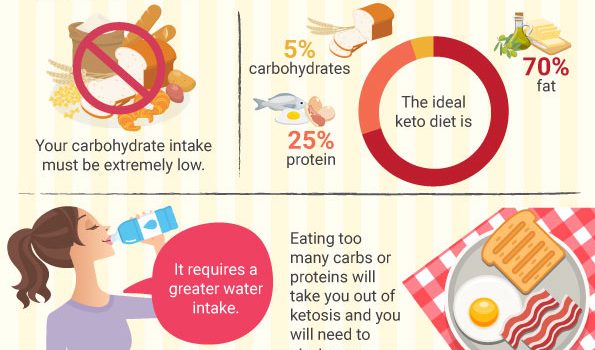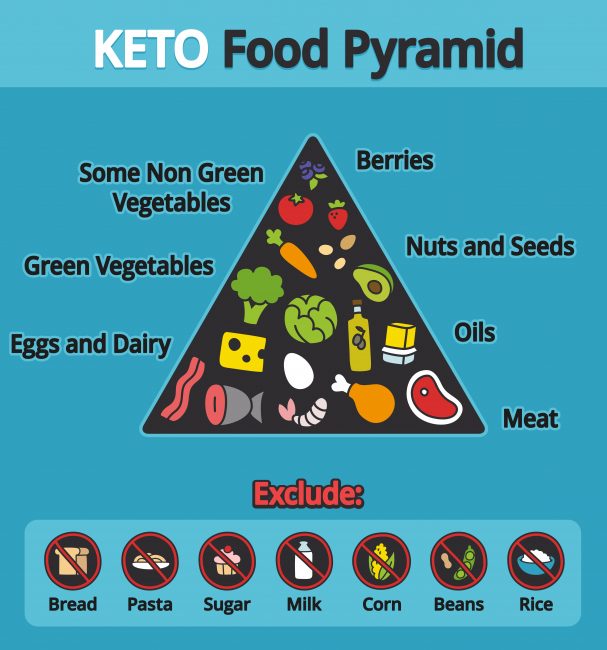CONTENTS

For the past year, the keto diet has been in the news, blogs, the tabloids, in scientific research papers, and probably discussed around the tables of your favorite coffee shop. Maybe you’ve looked into it offhand and dismissed it as a butter-centric fad diet.
For many people, though, ketogenic diets are here to stay. The keto diet has been adopted by a large number of health enthusiasts.
It’s attracting people who want to lose weight as well as cleanse and rejuvenate their bodies.
People in the bodybuilding and fitness communities use it to trim up before competitions. Some people even use a consistent, less restrictive form of the Ketogenic Diet long-term for the powerful physical and mental performance it is purported to offer.
The ketogenic diet refers to a low-carb, high-fat diet that forces your body to convert fat into energy sources called ketones. Ketone conversion happens in the liver. In order to get to the point where your body is able to produce ketones, your carbohydrate intake (and therefore glucose levels) must be extremely low. This is a reversal of the more common high-carb, low-fat diets. Because of this reversal, the keto diet will ask you to eat many things you might normally have shied away from for health reasons, including lots of butter, cheese, and fatty bacon.
Sound good? Here are a few things to consider before you go keto-friendly grocery shopping:
The Keto Diet in a Nutshell

The keto diet uses ketone conversion, which is the body’s backup method for deriving energy from nutrients.
So, if producing glucose from carbohydrates is the normal way to get energy from your food, then producing ketones is the body’s emergency method. It is also the easiest way to teach your body to burn its fat reserves without having it rely on blood sugar content.
While it’s not been proven yet, many people have hypothesized that a ketogenic diet will allow your body to burn fat more efficiently even when you are off the diet.
For the most part, a ketogenic diet can be described via a specific ratio of macro-nutrients. The ideal keto diet is around 70 percent fat, 25 percent protein, and 5 percent carbohydrates.
For best results, carbohydrates shouldn’t come from wheat and grains. Instead, the best keto carbs come from veggies, nuts, and dairy. Meals normally consist of a protein paired with a veggie and an extra side of fat. For a common example, cheesy chicken with creamed spinach.
Studies show that the ketogenic diet works in the short term for fat loss, but the long-term effects are uncertain.
There is a shortage of scientifically validated knowledge about the physiological mechanisms involved in this kind of digestion, and only a few high-level resources and scientific studies are available. Scientific concerns still exist regarding the diet.

Health Benefits of Ketogenic Diets

The ketogenic diet is a scientifically substantiated approach to reshaping your metabolism, losing weight, and enhancing mental focus.
While you’re on the keto diet, your insulin levels will drop, allowing your body to burn fat for its daily energy. It is also necessary for you to drink more water on this diet. As you drink over a gallon of water a day, you will flush out your system, clearing toxins that would normally prevent good digestive health and liver function.
Important for anyone who has experienced the frustration of hunger or the mid-day slump, keto-energy helps the mind to focus and remain balanced. Ketones give the body a different kind of energy than blood sugars.
Most people report that ketones bypass the boom and bust cycles of sugar-based energy. Rather than having highs and lows based on mealtimes, ketones give a steadier energy source from the fats they burn.
For anyone who wants to curb an overwhelming sweet tooth, ketogenic diets are also able to reduce sugar cravings. Sugars are addictive to the body, so the more sugars that your body is used to eating in a day, the more cravings for sugar you will experience. The ketogenic diet forces you to break this sugar addiction by using low-carb sweeteners such as Stevia, Inulin, and Erythritol. For this reason they might be a good match for people considering intermittent fasting, but are concerned about the drawbacks of such a diet.
Ketogenic meals tend to fill you up more than carbohydrate-intensive meals. While the sugars from carbohydrates can be addictive, causing you to eat even when you are full, fats will allow you to feel satisfied without continued cravings. At the same time, ketogenic diets improve triglyceride and cholesterol levels.
The Keto Flu
Most people trying the keto diet out for the first time say that they feel sick or lightheaded for a few days.
If you’re switching from a high-carb, low-fat lifestyle to the high-fat, low-carb ketogenic diet, you will certainly feel a transition period. On forums, this is commonly referred to as the keto flu.
Side-effects could include general exhaustion, headaches, dizziness, mental fogginess, and feelings of aggravation. Most of this comes from losing water-weight early on. So, to combat these side-effects, drink as much water as you can and replenish your electrolytes by adding extra salt to your food.
For anyone who works out regularly, having less energy can be disconcerting. As your body gets used to relying on ketones for its energy needs, you will most likely experience a short-term slump. You might also notice drops in physical performance. Even experienced runners have reported having less endurance while transitioning.
There is also the problem of more dangerous, though more uncommon health risks, like ketoacidosis. Ketoacidosis is a common issue where ketone production is too high. This is more common for individuals with type 1 diabetes.
It is unlikely that anything too problematic will happen while you are on the keto diet. That being said, you might experience a number of rough, low-energy days and flu-like symptoms, including headaches and dizziness. To get advice tailored to your specific health class, always check in with your physician about your diet plan before starting the keto diet.
How to Start with the Keto Diet
For easy planning, you can find dietary guides on the internet and in the form of published books.
Some will advise you to begin by gradually reducing your carbohydrate intake before diving right into the keto diet. This will ease you in, but it will also prolong the amount of time it takes to consistently burn fat. If you’re the sort of person who does not want to quit your starches cold turkey, this easier pace will allow you to diet better without being deterred by a harsh first few days.
Other guides recommend a fasting period at the beginning of ketogenic dieting. Fasting helps you to rid the sugars left over from eating carbs.
This immediate switch to the keto diet’s high-fat intake allows quicker ketone production. On a quick start-up plan like this, you will notice fat-loss sooner. However, fasting risks burnout. If you plan to do it this way, make sure you have support from your friends and family. Have a diet buddy and get your family on board with ketogenic snacks while you’re dieting.
To begin with, much of the immediate lost weight will be water-weight. Like a more intensified version of waking up in the morning and finding yourself thinner than the night before, the weight loss from losing water-weight is not a long-term effect. In order to get into the intense fat-loss that the keto diet is known for, you will need to stick with it for a few weeks.
No matter what guide you choose, the keto diet means commitment. Before you begin, it’s best to make sure that you have a keto diet plan. This includes keto meal plans and keto snacks, such as almonds, full fat cheese, seeds, hummus, dark chocolate, guacamole, Bulletproof Coffee, and green bean fries.
No products found.
No products found.
Planning ahead will keep you from reverting to a high carb diet. Otherwise, you could risk eating too many carbs or too much protein, throwing your body out of ketosis. Keto entrees can be diverse and delicious, try a Caprese salad with fresh mozzarella and cherry tomatoes, or homemade ice-cream using keto-friendly sweeteners.
The Keto Diet is Best When Used as a Tool
Will it get you trim? The bottom line is that for most bodies, you won’t lose more weight on the keto diet than on your high-carb, low-fat alternative. As long as you’re strictly limiting either carbs or fats, you will hit your dieting goals. The key is the strictness of the diet, preferring one macro above the other, and the exercise that lightens the scale.
One of the keto diet’s benefits for this kind of weight-loss is that you can’t cheat and still be doing it. With a low-fat diet, you can cheat some days, eat a little more fat, and still consider yourself to be dieting. But with a keto diet, eating too many carbs or too much protein will take you out of ketosis. If you cannot reach ketosis, then you’re really not doing the keto diet. The strictness of this diet will, therefore, make it a powerful tool for people who need a little more structure to stay on track.
To get the most from a ketogenic diet, know what you want from it. Are you looking for weight loss? Muscle building or brain boosting? You use a macro-nutrient calculator or this keto calculator to target your desired results with the correct nutrient percentages.
Schedule your diet into your lifestyle. Check your timeline and set aside a solid month to diet. Make sure this is a month that won’t be full of temptations and distractions like the holiday season. You can also try to arrange it so that the worst fatigue at the end of the first week lands on your weekend. This way you can rest while your body adjusts.
If you decide to use the keto diet to lose weight or trim up, you will join a large and enthusiastic community of ketogenic diet enthusiasts. To get your best results, set yourself up for success. One break or cheat in the keto diet could disrupt your ketone production, setting you back weeks. Yet it’s easier to stay on path by keeping a diary to hold yourself accountable. finding a guide that suits your lifestyle, and joining a keto diet support forum to share your experience with others.




Great article.
It answers a lot of frequently asked questions.
Thank you!